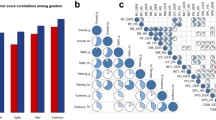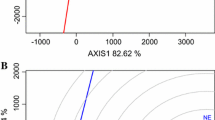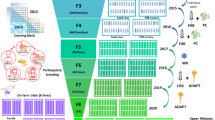Abstract
This study aimed to investigate a cultivar selection criterion based on income ha−1 in common wheat. Regional yield trials with 20 entries were planted in Diyarbakır, Hazro and Ceylanpınar in southeast Anatolia in the 2004/2005 growing season. A randomized complete block design with four replications was employed. Grain samples from each location were subjected to quality analyses, and then presented to randomly selected grain purchasers with the local commodity market for market price estimations. Entries 1, 9, 10, 7 and 6 were the top five ranking entries for grain yield, giving 5,320, 5,290, 5,280, 5,140 and 5,130 kg ha−1, respectively. From the market price perspective, entries 17, 3, 7, 20 and 8 received the five highest marketing price offers with the values 239.0, 238.1, 237.1, 236.9 and 236.7 US$ tonne−1, respectively. There was a US$ 10.94 tonne−1 market price difference between entries with the highest and the lowest market price. The only quality analyses showing significant correlations with market price were Zeleny sedimentation value and hectolitre weights (kg hl−1). From thev production income [= marketing price (US$ tonne−1) × grain yield (kg ha−1)] point of view, entries 9, 10, 1, 7 and 6 were ranked from 1st to 5th for production income ha−1 with the values 1,241.0, 1,238.0, 1,219.9, 1,214.2 and 1,209.3 US$ ha−1, respectively. All five high yielding entries were also high-income entries. A rank stability analysis further indicated that entry numbers 6, 7, 8, 4 and 1 stable for high production income ha−1. A simulation study, based on allocation of additional premiums for high quality indicated that entries 9,1,10, 7, and 6 would be top ranking for high income ha−1 if given an additional premium of as much as twice the standard deviations of market price for each entry (the highest premium limit; 20.24 US$ tonne−1). The order for cultivar preference for high production income ha−1 would change and would generate 1,321.94, 1,296.20, 1,281.11, 1,258.06 and 1,243.01 US$ ha−1, respectively. It was concluded that the relatively quality conscious Şanlıurfa commodity market does not offer adequate premiums for the high quality grains. This results in farmer preference for high yielding lower quality cultivars. Even though quality cannot be neglected, and cultivar preference could change with additional premiums, breeders must give more attention to high production income ha−1.
Similar content being viewed by others
References
Açıkgöz N, Akkaş ME, Moghaddom A, özcan K (1994) Tarist: PC’ler için Veri Tabanı Esaslı Türkçe İstatistik Paketi. Tarla Bitkileri Kongresi Bitki Islah Bildirileri, 25–29 Nisan 1994, S: 264–267, Bornova
Açıkgöz N, İlker E, Gökçöl A (2004) TOTEMSTAT. Biyolojik araştırmaların bilgisayarda değerlendirilmesi. E.Ü.Tohum teknolojisi ve Araştırma Merkezi Yayın no:2, İzmir
Ahmedi Esfahani FZ, Stanmore RG (1997) Export demand for attributes of Australian wheat in Asia and Middle East. Food Policy 22:145–154
Anonymous (1990) Test weight per bushel. Approved methods of the American Association of Cereal Chemists No: 55–10
Anonymous (1999) Yıllık gelişme raporları. Güneydoğu Anadolu Tar. Arş. Ens. P.K:72 Diyarbakır
Anonymous (2001) GAP İl İstatistikleri. http://www.tarim.gov.tr/istatistikler/gap/tahıl/
Anonymous (2002a) Preparation of test flour for sedimentation test from wheat samples. International Association of Cereal Chemistry. ICC Standard N0: 118
Anonymous (2002b) Determination of wet gluten quantity and quality (Gluten index ac. To Perten) of whole wheat meal and wheat flour (Triticum aestivum). International Association of Cereal Chemistry. ICC Standard No:155
Anonymous (2002c) TMO ekmeklik buğday alım baremleri. TMO Genel Müdürlügˇü, Ankara
Brennan JP (1992) Economic issues in the establishment of plant breeding programs to meet market requirements. In: XXX (Ed.) Proc Grain Research Symp, The Univ. of Sydney, pp 23–31
Brush StB, Meng E (1998) Farmer’s valuation and conservation of crop genetic resources. Genet Resour Crop Evol 45:139–150
Ceccarelli S, Grando S (2005) Participatory plant breeding: a fast track to variety development. Proc ASA-CSSA-SSSA int. annual meeting. http://crops.confex.com/crops/2005am/techprogram/P7050.htm
CIMMYT (1997) Adoption of improved wheat varieties in developing countries. Chapter 4.http://www.cimmyt.org/ Research/Economics/map/impact_studies/wheat1966_97/ w6chapter 4.pdf
CIMMYT (2005) Impacts of international wheat breeding research in the developing world, 1960–1990. Executive summary. http://www.cimmyt.org/Research/Economics/Revisar/htm/whesumma.htm
Demir E (2005) Anaç olarak kullanılabilecek bazı ekmeklik buğday çeşit ve hatlarının bazı özelliklerinde genetik varyasyonun saptanması. Tarla Bitkileri Ana Bilim dalı, Harran Üniv. Zir. Fak. şanlıurfa (Masters Thesis)
Edwards IB (1997) A global approach to wheat quality. Wheat quality conference, Manhattan, Kansas, May, 1997 (http://stars.kansas.net/iwge/keyedwa.htm)
Genç İ, Kırtok Y, Yağbasanlar T, Koç M, Özkan H (1992) Güneydoğu Anadolu BÖlgesinde sulu koşullara uygun ekmeklik ve makarnalık buğday çeşitlerinin tespiti üzerine araştırmalar. Kesin Sonuç raporu. ç.ü.Z.F. genel yayın No:30, GAP Yayın No: 59, Adana
Huehn M (1990) Non parametric estimation and testing of g x e interactions by rank. In: Manjif SK (ed) Genotype × environment interactions and plant breeding. Dept. of Agr. Louisiana State Univ., USA, pp 69–93
Inglis A (1992) Producing a better product; a grain grower’s perspective. In: The proceedings of the grain research. symposium The Univ. of Sydney, pp 9–15
Lee M, Lerohl M, Unterschultz J (2000) Buyer preference for durum wheat: a stated preference approach. Int. Food Agro Business Man. Rev 3:353–366
Lin W, Vocke G (1998) Hard white wheat: changing the color of U.S. wheat? Agricultural Outlook/August 1998. Economic Research Service, USDA. http://www.ers.usda.gov/publications/agoutlook/aug1998/ao253e.pdf
Lin W, Vocke G (2004) Hard white what at the crossroads. Electronic Outlook Report from the Economic Research Service. http://www. ers.usda.gov
Marshall DR, O’Brien L (1992) Breeding for quality: the key to future of the grain industry. In: The proceeding of the grain research symposium. The Univ. of Sydney, pp 9–15
Özberk İ, Özberk F (1994) Ekmeklik buğdayda verim komponentleri ve verim arasındaki ilişkiler. Güneydoğu Anadolu Tar. Arş.Ens. şubat 1994, P.K:72, Diyarbakır
Özberk İ, Özberk F, Coşkun Y (2002a) Harran ovasında ekmeklik buğdayda verim ve bazı verim Öğeleri arası ilişkiler. Harran Üniv Zir Fak Dergisi 6(1–2):39–45
Özberk İ, Özberk F, Öktem A (2002b) Harran ovası koşullarında bazı ekmeklik buğday (T. aestivum) bÖlge verim denemelerinde bazı istatistik analizler. Çukurova Üniv Zir Fak Dergisi 17(3):111–118
Özberk İ, Atlı A, Pfeiffer W, Özberk F, Coşkun Y (2005a) The effect of sunn pest (Eurigaster integriceps) damage on durum wheat: impact in the market place. Crop Protect 24(3):267–274
Özberk İ, Atlı A, Yücel A, Özberk F, Çoşkun Y (2005b) Wheat stem sawfly (Cephus pygmaeus L.) damage; impacts on grain yield, quality and marketing prices in Anatolia. Crop Protect 24:1054–1060
Özberk İ, Özberk F, Braun HJ (2005c) AMMI stability of some of internationally derived durum wheat varieties in the South-east of Anatolia. Pakistan J Biol Sci 8(1):118–122
Porter LL, Barkley A (1995) Does quality matter? Report of progress 730. Kansas State University, Manhattan, USA
Storey RJ (1992) From marketplace to breeder; getting the message through. In: The proceeding of the grain research symposium. The Univ. of Sydney, pp 17–22
Uluöz M (1965) Wheat, flour and bread analysis. EUZF Pub. No: 57, İzmir, Turkey
Weber WE, Wricle G (1990) In: Manjif, S.K. (ed) Genotype x environment interactions and plant breeding. Dept. of Agr. Lousiana State Univ., USA, pp 1–19
Zegeye T, Taye G, Taner D, Verkuijl H, Agidie A, Mwangi W (2001) Adoption of improved bread wheat varieties and inorganic fertilizer by small-scale farmers in Yelmana Densa and Farta districts of Northwestern Ethiopia. Ethiopia Agricultural Research Organization and International Maize and Wheat Improvement Center (CIMMYT), Mexico D.F
Author information
Authors and Affiliations
Corresponding author
Rights and permissions
About this article
Cite this article
Özberk, İ., Kılıç, H., Atlı, A. et al. Selection of wheat based on economic returns per unit area. Euphytica 152, 235–245 (2006). https://doi.org/10.1007/s10681-006-9205-5
Received:
Accepted:
Published:
Issue Date:
DOI: https://doi.org/10.1007/s10681-006-9205-5




